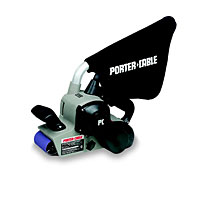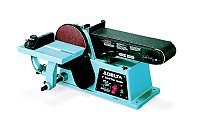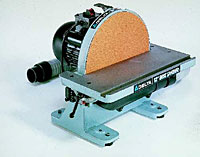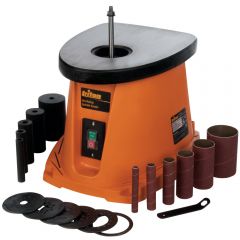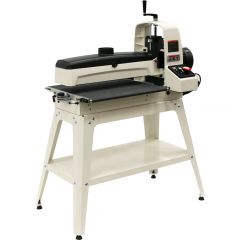Helping woodworkers online for over 20 years
Sanders
|
You have carefull selected the material, measured twice, cut once with your sharpest blade, carefully glued the parts together with biscuits for perfect alignment. Unless the surface is smooth all this is for naught, the finishing must be perfect also, this is when your choice of sander comes into play. There are many different types of sanders, from a piece of sandpaper wrapped around a scrap of wood to huge power fed machines, not all of these are within the budget of the hobbiest, but many are and the choices can be over-whelming, there are belt sanders, disk sanders, drum sanders, pad sanders and combinations of each. The selection depends on the job at hand, some remove a lot of material very quickly, and are used at the start of the project, others work slower but achieve the perfect finish we are all looking for. The other choice we have is how agressive we want the tool to work, this is determined by the grit of the sandpaper. |
|
Regardless of size, all belt sanders operate on the same principle: a sandpaper belt wraps around a rear roller and a front roller. The drive roller connected to the motor spins, causing the sanding belt to move forward like the tread of a bulldozer. This is far more aggressive than other types of sanders and is used to remove a lot of material quickly so one must be careful that the material is not gouged by holding it in one place too long.
These hand sanders are usually available with 3" or 4" wide belts from 18" to 24" in circumference. There are now special models with narrower belts and smaller front rollers to allow the sander to get into smaller spaces such as deck or stair rails. Contrary to all advice about sanding in the direction of the grain these machines usually will do a better job of leveling the boards in a glued up panel when run across the grain. This is because the length of the platen runs across the boards of different heights rather than riding along the edge of a board and gouging the low areas which will cause a wavy surface.
These models are a combination of a belt and disk , the belts are from 4" to 6" wide, the disks are from 6" to 9" round. They feature adjustable tables to sand at an angle. Disk sanders have been around about as long as electric hand drills, a sanding disk was one of the first attachments offered for drills. One of the problems with the original disk sanders was circular marks left from the spinning disk, this has been eliminated with the new style randon orbit models.
The random orbit action of these sanders will give a professional finish to your project. The hook and loop pad makes changing disks a snap.
This style of sander features a tilting table and a slot for a sliding miter gauge, very handy for adjusting the length of cut pieces or tweaking miter cuts when making picture frames. Some models also include a belt sanding feature. Shop Rockler.com
Drum SandersDrum sanders come in many different styles and a sizes, some attach to electric motors, others to drills and there are oscillating models to be used on a bench or hand held. The advantage of the oscillating models is the elimination of marks left on your material from the drum. Large models with multiple drums and a conveyor type feed are available to sand panels and cupboard doors. Spindle Sander
Spindle sanders have a vertical sanding drum that oscillates as it spins, very handy to clean up the edges of small projects. Drum Sander
These machine have a wide drum and a belt that carriers the material through the head, used to finish panels and other large surfaces. |

|

